Thermal Response Characteristics of Intermittently Cooled Room with Tube-Embedded Cooling Slab and Optimization of Intermittent Control †
Abstract
:1. Introduction
2. Methodology
2.1. Simulation Tool
2.2. Building and System Simulation Model
2.3. Intermittent Control Analysis and Optimization
3. Results and Discussion
3.1. Thermal Environment Responsive Characteristics of Intermittently Cooled Room by Tube-embedded Slab
3.1.1. Dynamic Thermal Response Characteristics of Cooling Slab
3.1.2. Response of Indoor Air Temperature and Mean Radiant Temperature to Intermittent Operation
3.1.3. Dynamic Thermal Response Characteristics of Passive Wall
3.1.4. Comparison of Dynamic Response Characteristics of Indoor Thermal Environment between Nighttime Cooling and Daytime Cooling
3.2. Optimization of Intermittent Cooling Schemes
3.2.1. Optimization of Cooling Duration
3.2.2. Optimization of Distribution of the Time for Cooling
3.2.3. Variable Water Temperature Control Scheme
3.3. Optimization of Intermittent Cooling Schemes in Other Climate Zones of China
4. Conclusions
- For TESCS, intermittent cooling will not cause indoor thermal environment parameters to fluctuate significantly and can keep indoor temperature basically stable.
- The tube-embedded slab has significant heat storage and release characteristics under the intermittent cooling condition, and the maximum value of the heat flux density of the cooling surface appears about one hour after the stop of cooling. The passive interior wall also has a certain amount of cooling energy storage and also has heat storage and release characteristics under the intermittent cooling condition, but its cooling capacity is very small.
- The required total cooling capacity increases with the increase of the cooling duration. Reducing the duration of the cooling can reduce the system energy consumption. However, increasing the cooling duration can reduce the peak load and the installed capacity of the chiller. The scheme of 24-h cooling can reduce the peak load about 70%, 67%, and 41%, respectively, compared with 6-h cooling, 8-h cooling, and 12-h cooling. Frequent starts and stops of the pump under the same duration of cooling can increase the cooling capacity obtained by the room to a certain extent. Under the nighttime cooling mode, the effect of the cooling duration on the indoor thermal comfort and system energy efficiency is much greater than the cooling time distribution. It is very important to choose the appropriate cooling duration in the optimization of the intermittent control strategy.
- Compared with nighttime cooling, daytime cooling can provide a higher thermal comfort level and lower system energy consumption. However, nighttime cooling can reduce the chiller’s installed capacity by about 25%. It can also shift the peak load off of peak hours and use low-price nighttime electricity, which will lead to the savings of the operating cost.
- On the basis of the intermittent operation, combining variable water temperature control can well restrain the fluctuation of indoor air temperature, due to the large change of the outdoor air temperature in the cooling season, so as to achieve the dual goals of thermal comfort and energy saving better.
- From the perspective of dual-objective optimization for thermal comfort and energy-saving, four hours, eight hours, ten hours, and fourteen hours are the optimal cooling durations for the typical office building with a typical envelope structure and embedded tube parameters under the condition of using a supply water with a temperature of 19 °C in Shenyang, Xi’an, Shanghai and Guangzhou, respectively.
- This study selected a typical office building in Xi’an, a typical, representative city of the cold zone in China as the case study, and the optimization study was also extended to wider climate zones of China. For office buildings with similar thermal characteristics, the results are representative. For other types of buildings with different thermal characteristics, such as houses, apartment, or hotels, and so forth, the results may be different. Due to the thermal coupling between the cooling elements of TESCS and the building structure, intermittent operating schemes are sensitive to climatic characteristics, building thermal characteristics, and building load characteristics. Therefore, the intermittent operation scheme has certain applicability to climatic characteristics and building load characteristics. Due to the heat storage characteristics of TESCS, the intermittent operation is also feasible in other types of buildings. However, the optimal intermittent operation scheme may take a different form from the results in this study. It requires further research in the future.
Author Contributions
Funding
Conflicts of Interest
References
- International Energy Agency. Energy Technology Perspectives; International Energy Agency: Paris, France, 2017. [Google Scholar]
- Caniato, M.; Gasparella, A. Discriminating people’s attitude towards building physical features in sustainable and conventional buildings. Energies 2019, 12, 1429. [Google Scholar] [CrossRef] [Green Version]
- Sadollah, A.; Nasir, M.; Geem, Z.W. Sustainability and Optimization: From Conceptual Fundamentals to Applications. Sustainability 2020, 12, 2027. [Google Scholar] [CrossRef] [Green Version]
- Chartered Institution of Building Services Engineers. CIBSE Guide B-heating, Ventilating, Air Conditioning and Refrigeration; The Chartered Institution of Building Services Engineers: London, UK, 2007. [Google Scholar]
- Feustel, H.E.; Stetiu, C. Hydronic radiant cooling-preliminary assessment. Energy Build. 1995, 22, 193–205. [Google Scholar] [CrossRef]
- Babiak, J.; Olesen, B.W.; Petrás, D. Low Temperature Heating and High Temperature Cooling; Federation of European Heating and Air Conditioning Associations: Brussels, Belgium, 2009. [Google Scholar]
- Imanari, T.; Omori, T.; Bogaki, K. Thermal comfort and energy consumption of the radiant ceiling panel system: Comparison with the conventional all-air system. Energy Build. 1999, 30, 167–175. [Google Scholar] [CrossRef]
- Nagano, K.; Mochida, T. Experiments on thermal environmental design of ceiling radiant cooling for supine human subjects. Build. Environ. 2004, 39, 267–275. [Google Scholar] [CrossRef]
- Lin, B.R.; Wang, Z.; Sun, H.L.; Zhu, Y.X.; Ouyang, Q. Evaluation and comparison of thermal comfort of convective and radiant heating terminals in office buildings. Build. Environ. 2016, 106, 91–102. [Google Scholar] [CrossRef]
- Sui, X.M.; Zhang, X. Analysis on combinations of indoor thermal microclimate parameters in radiant cooled residential buildings and drawing of new thermal comfort charts. Build. Serv. Eng. Res. Technol. 2016, 37, 66–84. [Google Scholar] [CrossRef]
- Tian, Z.; Love, J.A. Energy performance optimization of radiant slab cooling using building simulation and field measurements. Energy. Build. 2009, 41, 320–330. [Google Scholar] [CrossRef]
- Wang, S.; Morimoto, M.; Soeda, H.; Yamashita, T. Evaluating the low exergy of chilled water in a radiant cooling system. Energy Build. 2008, 40, 1856–1865. [Google Scholar] [CrossRef]
- Niu, J.L.; Zhang, L.Z.; Zuo, H.G. Energy savings potential of chilled-ceiling combined with desiccant cooling in hot and humid climates. Energy Build. 2002, 34, 487–495. [Google Scholar] [CrossRef]
- Niu, J.L.; Kooi, J.V.D.; Rhee, H.V.D. Energy saving possibilities with cooled ceiling system. Energy Build. 1995, 23, 147–158. [Google Scholar] [CrossRef]
- Saber, E.M.; Tham, K.W.; Leibundgut, H. A review of high temperature cooling systems in tropical buildings. Build. Environ. 2016, 96, 237–249. [Google Scholar] [CrossRef] [Green Version]
- Rhee, K.; Olesen, B.W.; Kim, K.W. Ten questions about radiant heating and cooling systems. Build. Environ. 2017, 112, 367–381. [Google Scholar] [CrossRef] [Green Version]
- European Committee for Standardization. EN 15377-3: Heating Systems in Buildings-design of Embedded Water Based Surface Heating and Cooling Systems, Part 3: Optimizing for Use of Renewable Energy Sources; European Committee for Standardization: Brussels, Belgium, 2007. [Google Scholar]
- Ren, J.; Zhu, L.; Wang, Y.; Wang, C.; Xiong, W. Very low temperature radiant heating/cooling indoor end system for efficient use of renewable energies. Sol. Energy 2010, 84, 1072–1083. [Google Scholar] [CrossRef]
- International Organization for Standardization. ISO 11855-1: Building Environment Design-Design, Dimensioning, Installation and Control of Embedded Radiant Heating and Cooling Systems; Part 1: Definition, Symbols, and Comfort Criteria; International Organization for Standard: Geneva, Switzerland, 2012. [Google Scholar]
- ASHRAE. 2016 ASHRAE Handbook-HVAC Systems and Equipment; American Society of Heating, Refrigerating, and Air Conditioning Engineers, Inc.: Atlanta, GA, USA, 2016. [Google Scholar]
- International Organization for Standardization. ISO 11855-2: Building Environment Design-Design, Dimensioning, Installation and Control of Embedded Radiant Heating and Cooling Systems, Part 2: Determination of the Design Heating and Cooling Capacity; International Organization for Standard: Geneva, Switzerland, 2012. [Google Scholar]
- Olesen, B.W. Using building mass to heat and cool. ASHRAE J. 2012, 54, 44–52. [Google Scholar]
- Koschenz, M.; Dorer, V. Interaction of an air system with concrete core conditioning. Energy Build. 1999, 30, 139–145. [Google Scholar] [CrossRef]
- Lehmann, B.; Dorer, V.; Koschenz, M. Application range of thermally-activated building systems TABS. Energy Build. 2007, 39, 593–598. [Google Scholar] [CrossRef]
- Rijksen, D.O.; Wisse, C.J.; Van Schijndel, A.W.M. Reducing peak requirements for cooling by using thermally activated building systems. Energy Build. 2010, 42, 298–304. [Google Scholar] [CrossRef]
- Karmann, C.; Schiavon, S.; Bauman, F. Thermal comfort in buildings using radiant vs. all-air systems: A critical literature review. Build. Environ. 2017, 111, 123–131. [Google Scholar] [CrossRef] [Green Version]
- Kim, K.; Olesen, B.W. Radiant heating and cooling systems: Part 2. ASHRAE J. 2015, 57, 28–37. [Google Scholar]
- Hu, R.; Niu, J.L. A review of the application of radiant cooling & heating systems in Mainland China. Energy Build. 2012, 52, 11–19. [Google Scholar]
- Güntensperger, W.; Gwerder, M.; Haas, A.; Lehmann, B.; Renggli, F. Control of concrete core conditioning systems. In Proceedings of the 8th REHVA World Congress for Building Technologies-CLIMA, Lausanne, Switzerland, 9–12 October 2005. [Google Scholar]
- Romaní, J.; De Gracia, A.; Cabeza, L.F. Simulation and control of thermally activated building systems (TABS). Energy Build. 2016, 127, 22–42. [Google Scholar]
- Lim, J.H.; Jo, J.H.; Kim, Y.Y.; Yeo, M.S.; Kim, K.W. Application of the control methods for radiant floor cooling system in residential buildings. Build. Environ. 2006, 41, 60–73. [Google Scholar] [CrossRef]
- Olesen, B.W. Radiant heating and cooling by embedded water-based systems. ASHRAE J. 1996, 1, 1–19. [Google Scholar]
- Song, D.; Kim, T.; Song, S.; Wang, S.H.; Leigh, S.B. Performance evaluation of a radiant floor cooling system integrated with dehumidified ventilation. Appl. Therm. Eng. 2008, 28, 299–1311. [Google Scholar] [CrossRef]
- Sourbron, M.; Helsen, L. Thermally activated building systems in office buildings: Impact of controller settings on energy performance and thermal comfort. In Proceedings of the 8th international Conference on System Simulation in Buildings, Liege, Belgium, 13–15 December 2010. [Google Scholar]
- Olesen, B.W.; Sommer, K.; Dïchting, B. Control of slab heating and cooling systems studied by dynamic computer simulations. ASHRAE Trans. 2002, 108, 698–707. [Google Scholar]
- Cho, S.H.; Zaheeruddin, M. Predictive control of intermittently operated radiant floor heating systems. Energy Convers. Manag. 2003, 44, 1333–1342. [Google Scholar] [CrossRef]
- Gwerder, M.; Tödtli, J.; Lehmann, B.; Dorer, V.; Güntensperger, W.; Renggli, F. Control of thermally activated building systems (TABS) in intermittent operation with pulse width modulation. Appl. Energy 2009, 86, 1606–1616. [Google Scholar] [CrossRef]
- Lehmann, B.; Dorer, V.; Gwerder, M.; Renggli, F.; Tödtli, J. Thermally activated building systems (TABS): Energy efficiency as a function of control strategy, hydronic circuit topology and (cold) generation system. Appl. Energy 2011, 88, 180–191. [Google Scholar] [CrossRef]
- TRNSYS 16. A Transient System Simulation Program; University of Wisconsin: Madison, WI, USA, 2006.
- Koschenz, M.; Lehmann, B. Thermoaktive Bauteilsysteme Tabs; EMPA Dübendorf Zentrum für Energie und Nachhaltigkeit: Dübendorf, Switzerland, 2000. [Google Scholar]
- Weber, T.; Johannesson, G.; Koschenz, M.; Lehmann, B.; Baumgartner, T. Validation of a FEM-program (frequency-domain) and a simplified RC-model (time-domain) for thermally activated building component systems (TABS) using measurement data. Energy Build. 2005, 37, 707–724. [Google Scholar] [CrossRef]
- Weber, T.; Johannesson, G. An optimized RC-network for thermally activated building components. Build. Environ. 2005, 40, 1–14. [Google Scholar] [CrossRef]
- Sourbron, M.; De Herdt, R.; Van Reet, T.; Van Passel, W.; Baelmans, M.; Helsen, L. Efficiently produced heat and cold is squandered by inappropriate control strategies: A case study. Energy Build. 2009, 41, 1091–1098. [Google Scholar] [CrossRef]
- Sui, X.; Wang, H.; Yan, J.; Guo, H. Optimal intermittent regulation of tubes-embedded building envelope cooling system. In Proceedings of the 10th International Symposium on Heating, Ventilation and Air Conditioning Conference, Jinan, China, 19–22 October 2017; pp. 2639–2646. [Google Scholar]
- Ministry of Housing and Urban-Rural Development of the People’s Republic of China. JGJ142-2012: Technical Specification for Radiant Heating and Cooling; China Architecture & Building Press: Beijing, China, 2012.
- Sui, X. Study on Sharing Rate of Cooling Load of Radiant Terminal Device and Air Supply Terminal Device in Residential Buildings. Ph.D. Thesis, Tongji University, Shanghai, China, 2009. [Google Scholar]
- Zhang, M. Research on Human Thermal Comfort in Non-uniform Radiant Cooling Environment and Design Optimization of It. Master’s Thesis, Chang’an University, Xi’an, China, 2014. [Google Scholar]
- International Organization for Standardization. ISO 7730: Moderate Thermal Environments: Determination of the PMV and PPD Indices and Specification of the Conditions for Thermal Comfort; International Standard Organization for Standardization: Geneva, Switzerland, 2005. [Google Scholar]
- Ministry of Housing and Urban-Rural Development of the People’s Republic of China. GB50189-2015: Design Standard for Energy Efficiency of Public Buildings; China Architecture & Building Press: Beijing, China, 2015.
- De Carli, M.; Tonon, M. Effect of modelling solar radiation on the cooling performance of radiant floors. Sol. Energy 2011, 85, 689–712. [Google Scholar] [CrossRef]
- Feng, J.J.; Schiavon, S.; Bauman, F. Impact of solar heat gain on radiant floor cooling system design. In Proceedings of the 11th REHVA World Congress, Prague, Czech Republic, 16–19 June 2013. [Google Scholar]

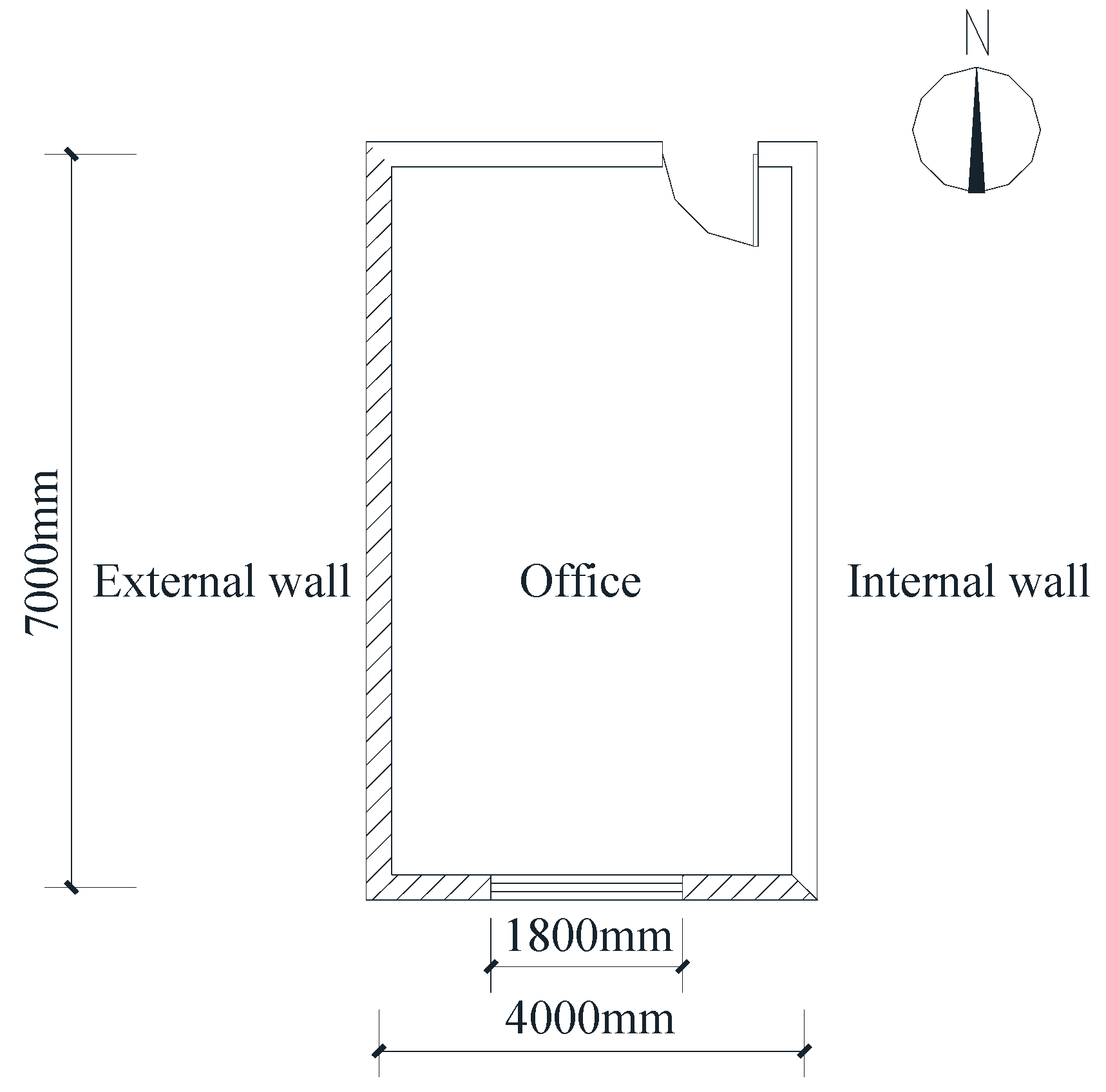


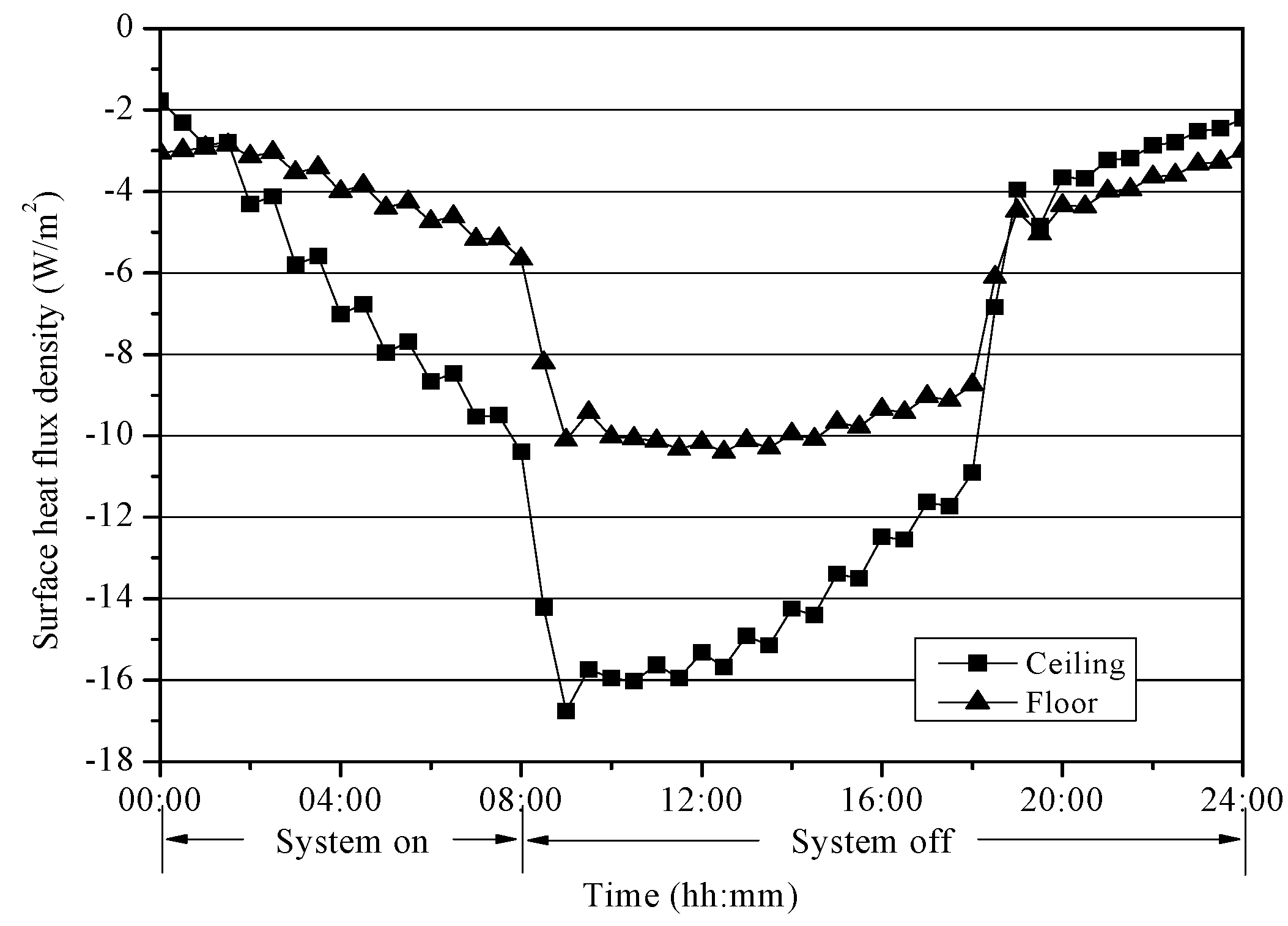





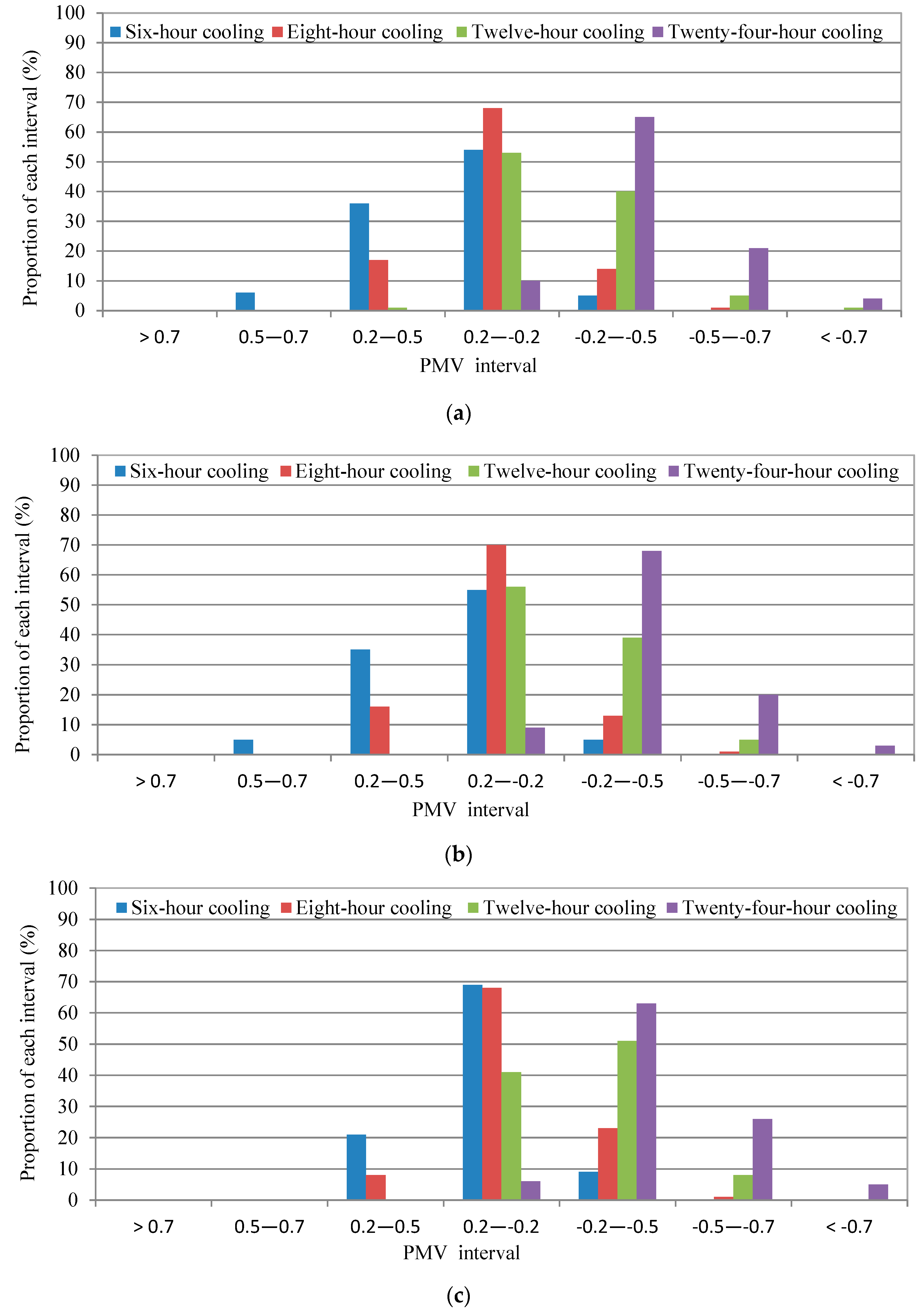


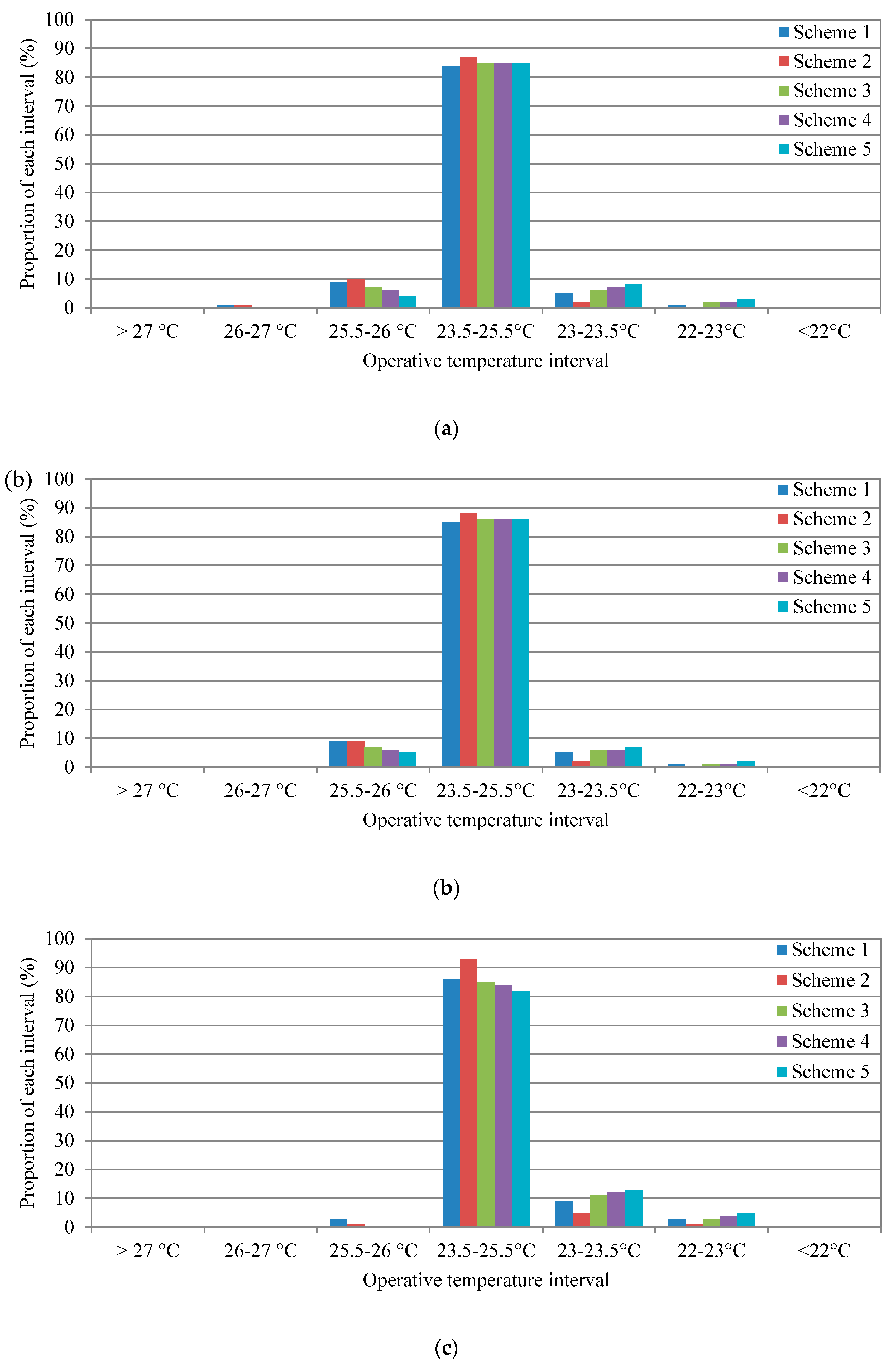

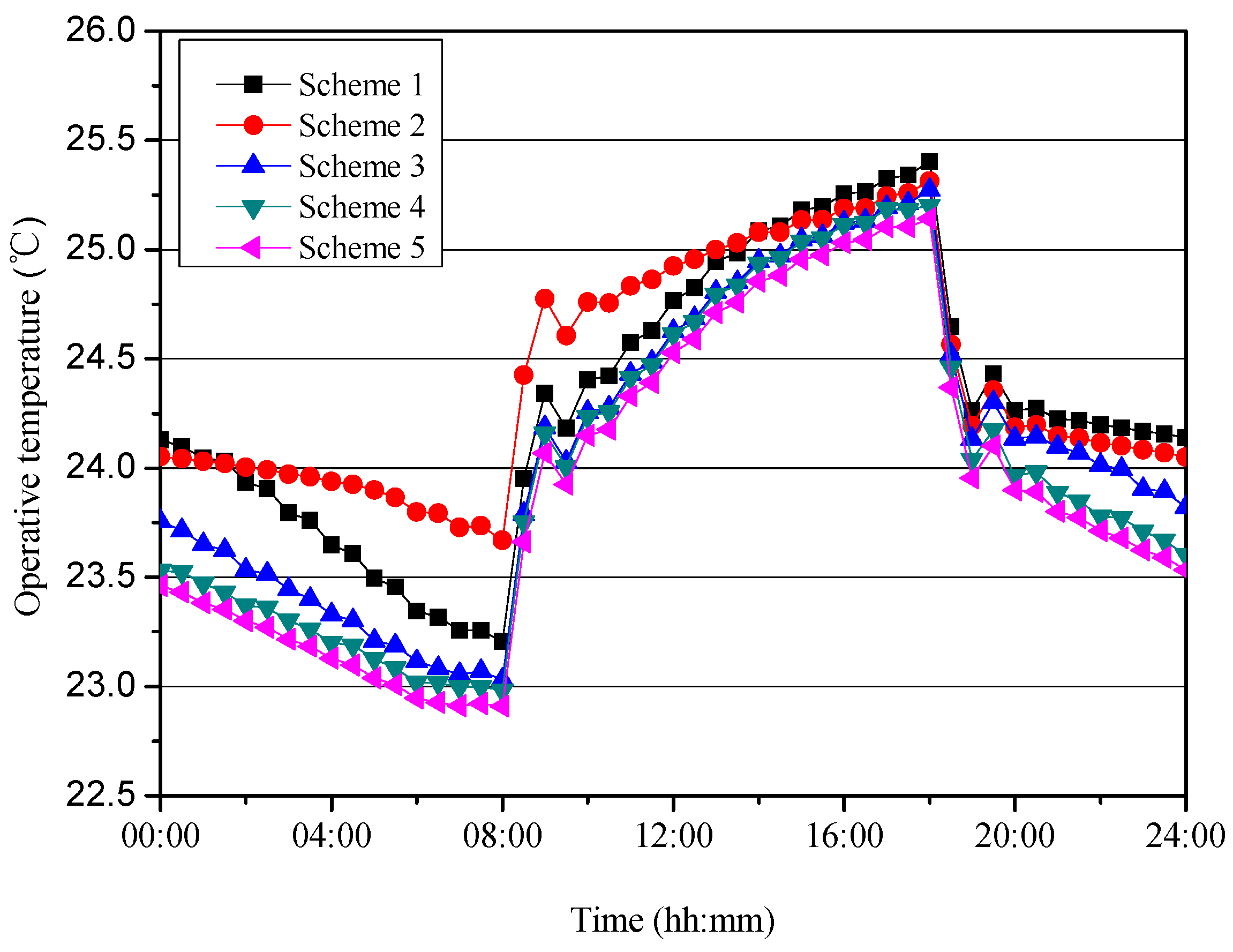


| Envelope | Structural Layer | Thickness (mm) | Thermal Conductivity Coefficient (W/m·K) | Heat Capacity (kJ/kg·K) | Density (kg/m3) | U-Value (W/m2·K) |
|---|---|---|---|---|---|---|
| South/west wall | Cement mortar | 20 | 1.25 | 0.84 | 2000 | 0.587 |
| Concrete block | 200 | 0.51 | 1 | 1400 | ||
| Low density polyurethane | 25 | 0.02 | 1.47 | 35 | ||
| North/east wall | Cement mortar | 20 | 1.25 | 0.84 | 2000 | 1.479 |
| Concrete block | 250 | 0.51 | 1 | 1400 | ||
| Slab | Ceramic tile | 20 | 0.83 | 0.84 | 1700 | 2.831 |
| Cement mortar | 40 | 1.25 | 0.84 | 2000 | ||
| Reinforced concrete | 280 | 2.2 | 0.84 | 2400 | ||
| Roof | Reinforced concrete | 280 | 2.2 | 0.84 | 2400 | 0.522 |
| Polystyrene foam | 45 | 0.03 | 1.47 | 15 | ||
| Floor | Ceramic tile | 20 | 0.83 | 0.84 | 1700 | 0.558 |
| Cement mortar | 40 | 1.25 | 0.84 | 2000 | ||
| Reinforced concrete | 280 | 2.2 | 0.84 | 2400 | ||
| Polystyrene foam | 40 | 0.03 | 1.47 | 15 |
| Tube Spacing (mm) | Tube Diameter (mm) | Tubing Wall Thickness (mm) | Thermal Conductivity Coefficient of Tubing Wall (W/m·K) | Water Supply Volume (kg/h) |
|---|---|---|---|---|
| 150 | 20 | 2 | 0.35 | 600 |
| Duration for Cooling | 6 h | 8 h | 12 h | 24 h |
|---|---|---|---|---|
| Capacity for cooling (kW·h) | 2721 | 3012 | 3533 | 4014 |
| Scheme Categories | Scheme 1 | Scheme 2 | Scheme 3 | Scheme 4 | Scheme 5 |
|---|---|---|---|---|---|
| Capacity for cooling (kW·h) | 3012 | 2992 | 3154 | 3228 | 3269 |
| Thermal Comfort Index | Partition Interval | Proportion (%) | ||
|---|---|---|---|---|
| Top Floor Room | Second Floor Room | Ground Floor Room | ||
| Operative temperature | >27 °C | 0 | 0 | 0 |
| 26–27°C | 0 | 0 | 0 | |
| 25.5–26°C | 0 | 0 | 0 | |
| 23.5–25.5°C | 14 | 13 | 3 | |
| 23–23.5°C | 43 | 43 | 17 | |
| 22–23°C | 43 | 43 | 77 | |
| < 22°C | 0 | 0 | 0 | |
| PMV | > 0.7 | 0 | 0 | 0 |
| 0.5–0.7 | 0 | 0 | 0 | |
| 0.2–0.5 | 0 | 0 | 0 | |
| 0.2 to −0.2 | 4 | 4 | 0 | |
| −0.2 to −0.5 | 82 | 82 | 46 | |
| −0.5 to −0.7 | 14 | 14 | 48 | |
| <−0.7 | 0 | 0 | 5 | |
| Thermal Comfort Index | Partition Interval | Proportion (%) | ||
|---|---|---|---|---|
| Top Floor Room | Second Floor Room | Ground Floor Room | ||
| Operative temperature | >27 °C | 0 | 0 | 0 |
| 26–27 °C | 0 | 0 | 0 | |
| 25.5–26 °C | 3 | 2 | 0 | |
| 23.5–25.5 °C | 97 | 98 | 100 | |
| 23–23.5 °C | 0 | 0 | 0 | |
| 22–23 °C | 0 | 0 | 0 | |
| <22 °C | 0 | 0 | 0 | |
| PMV | >0.7 | 0 | 0 | 0 |
| 0.5–0.7 | 0 | 0 | 0 | |
| 0.2–0.5 | 12 | 11 | 2 | |
| 0.2 to −0.2 | 87 | 87 | 93 | |
| −0.2 to −0.5 | 1 | 2 | 6 | |
| −0.5 to −0.7 | 0 | 0 | 0 | |
| <−0.7 | 0 | 0 | 0 | |
| Control Scheme | Equation (1) | Equation (2) | Constant Water Supply Temperature (19 °C) |
|---|---|---|---|
| Capacity for cooling (kW·h) | 3914 | 2883 | 2992 |
| Climate Zone | Representative City | Optimization of Cooling Duration | Optimization of Cooling Time Distribution | ||
|---|---|---|---|---|---|
| Intermittent Control Scheme | Optimal Duration | Intermittent Control Scheme | Optimal Scheme | ||
| Severe cold zone | Shenyang |
| 4 h |
| Scheme 2 |
| Hot summer and cold winter zone | Shanghai |
| 10 h |
| Scheme 2 |
| Hot summer and warm winter zone | Guangzhou |
| 14 h |
| Scheme 2 |
© 2020 by the authors. Licensee MDPI, Basel, Switzerland. This article is an open access article distributed under the terms and conditions of the Creative Commons Attribution (CC BY) license (http://creativecommons.org/licenses/by/4.0/).
Share and Cite
Sui, X.; Wang, H.; Qu, M.; Liu, H. Thermal Response Characteristics of Intermittently Cooled Room with Tube-Embedded Cooling Slab and Optimization of Intermittent Control. Energies 2020, 13, 1568. https://doi.org/10.3390/en13071568
Sui X, Wang H, Qu M, Liu H. Thermal Response Characteristics of Intermittently Cooled Room with Tube-Embedded Cooling Slab and Optimization of Intermittent Control. Energies. 2020; 13(7):1568. https://doi.org/10.3390/en13071568
Chicago/Turabian StyleSui, Xuemin, Huajiang Wang, Ming Qu, and Huitao Liu. 2020. "Thermal Response Characteristics of Intermittently Cooled Room with Tube-Embedded Cooling Slab and Optimization of Intermittent Control" Energies 13, no. 7: 1568. https://doi.org/10.3390/en13071568





